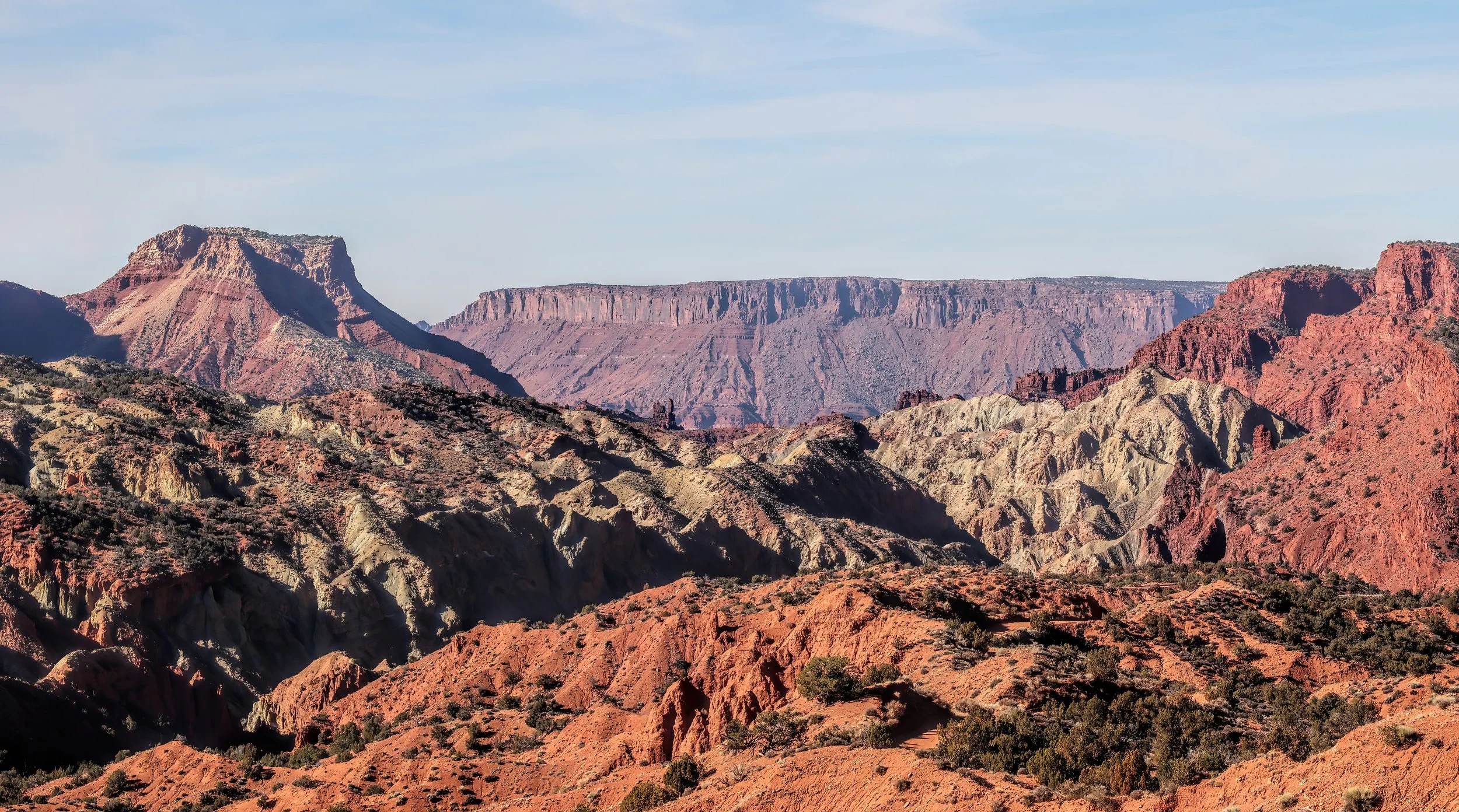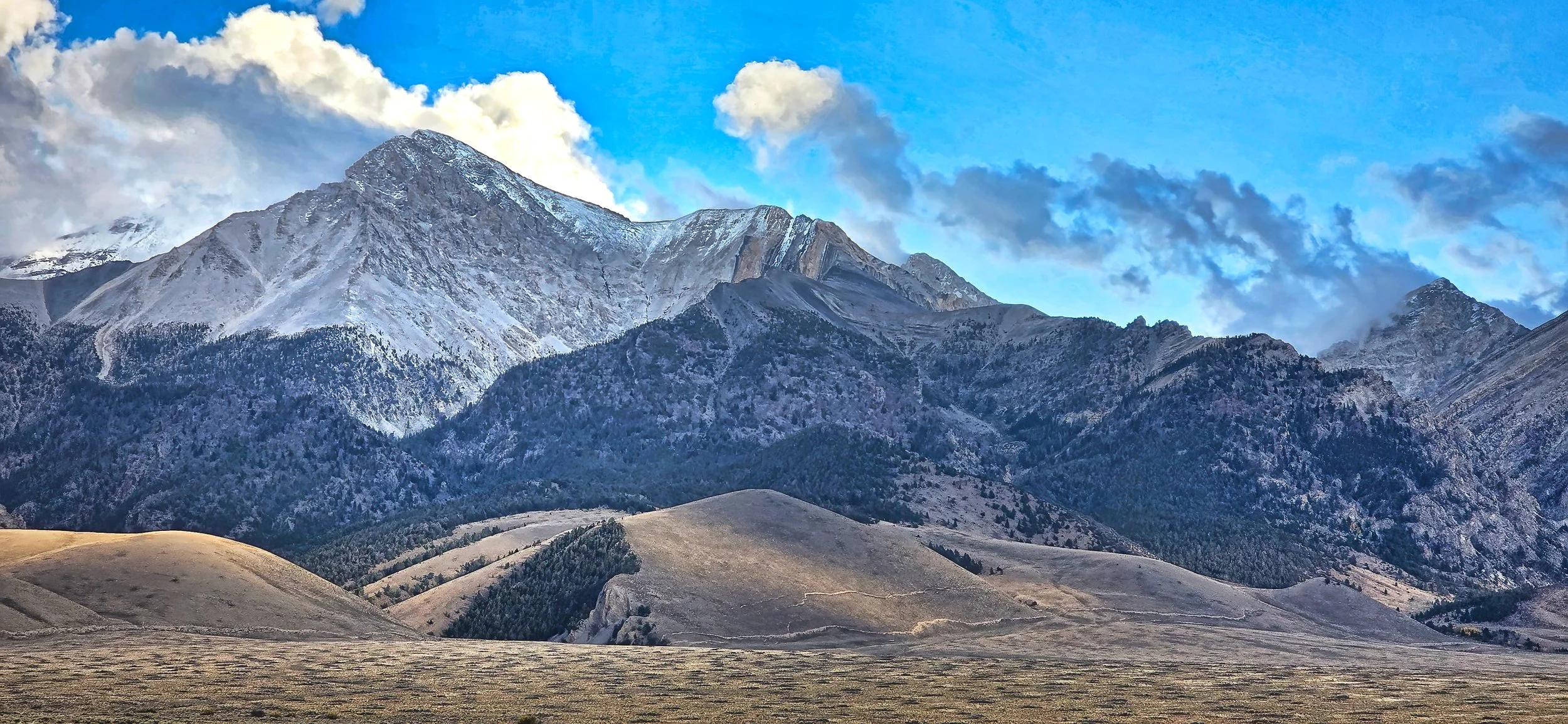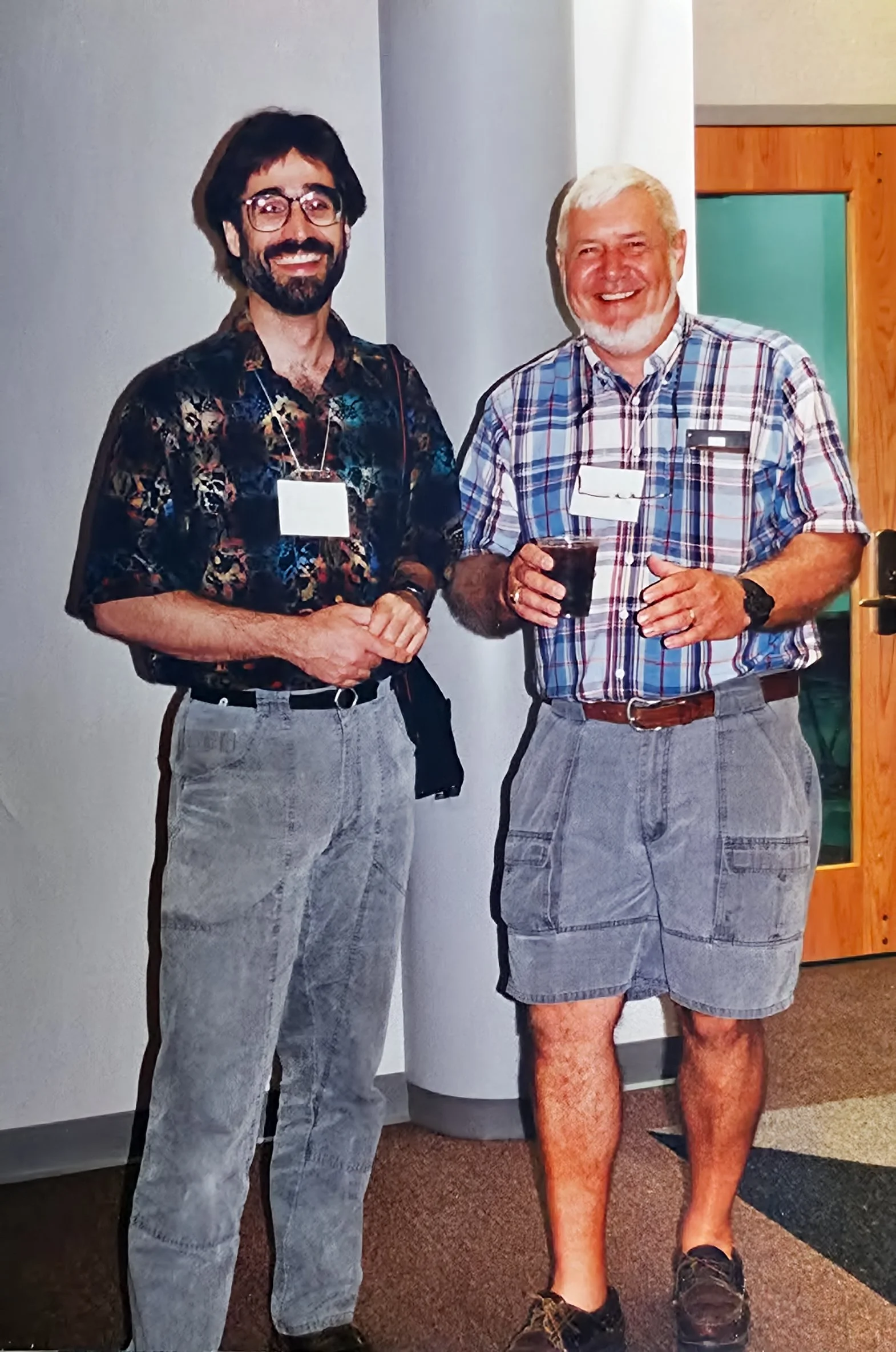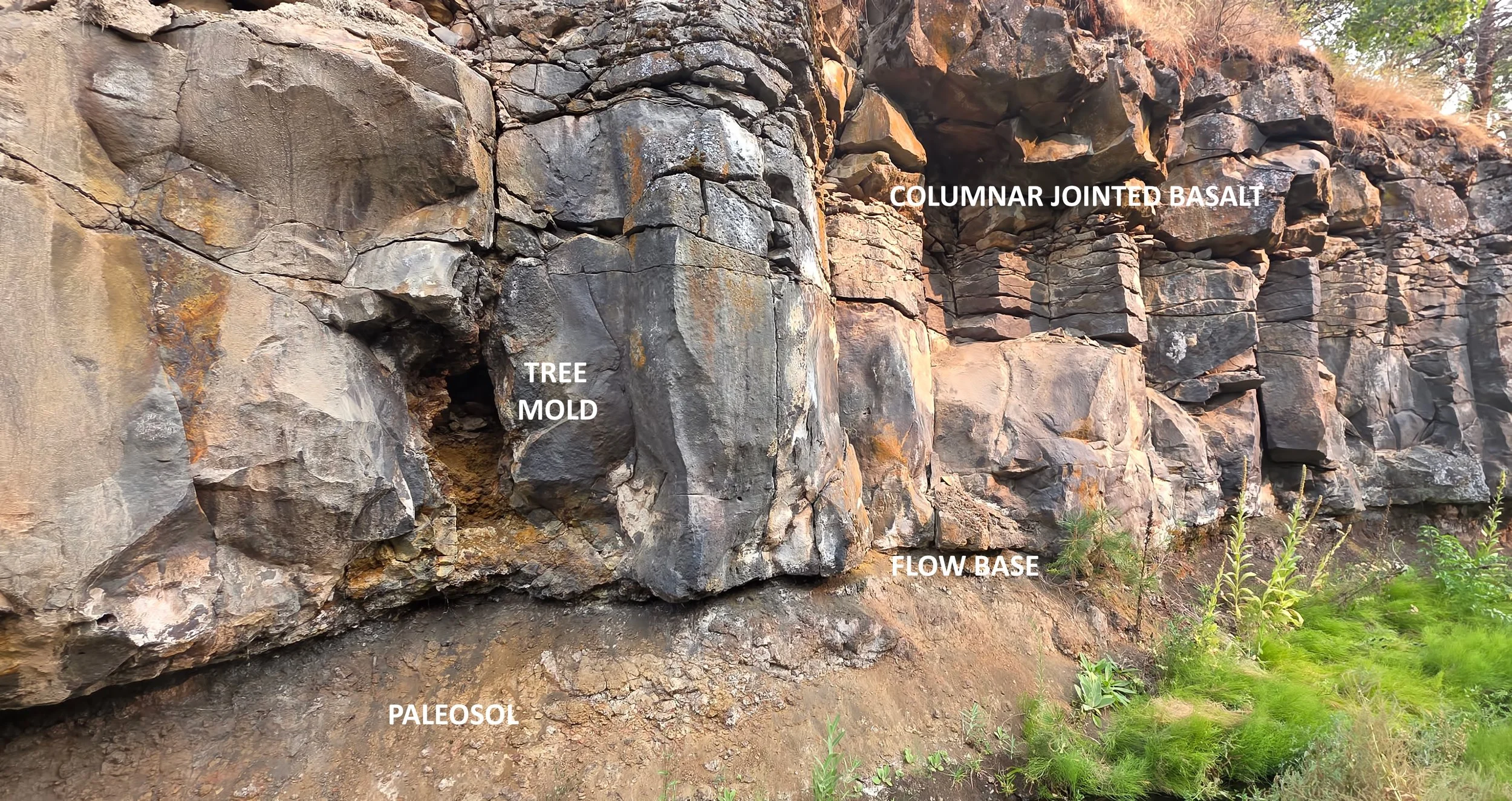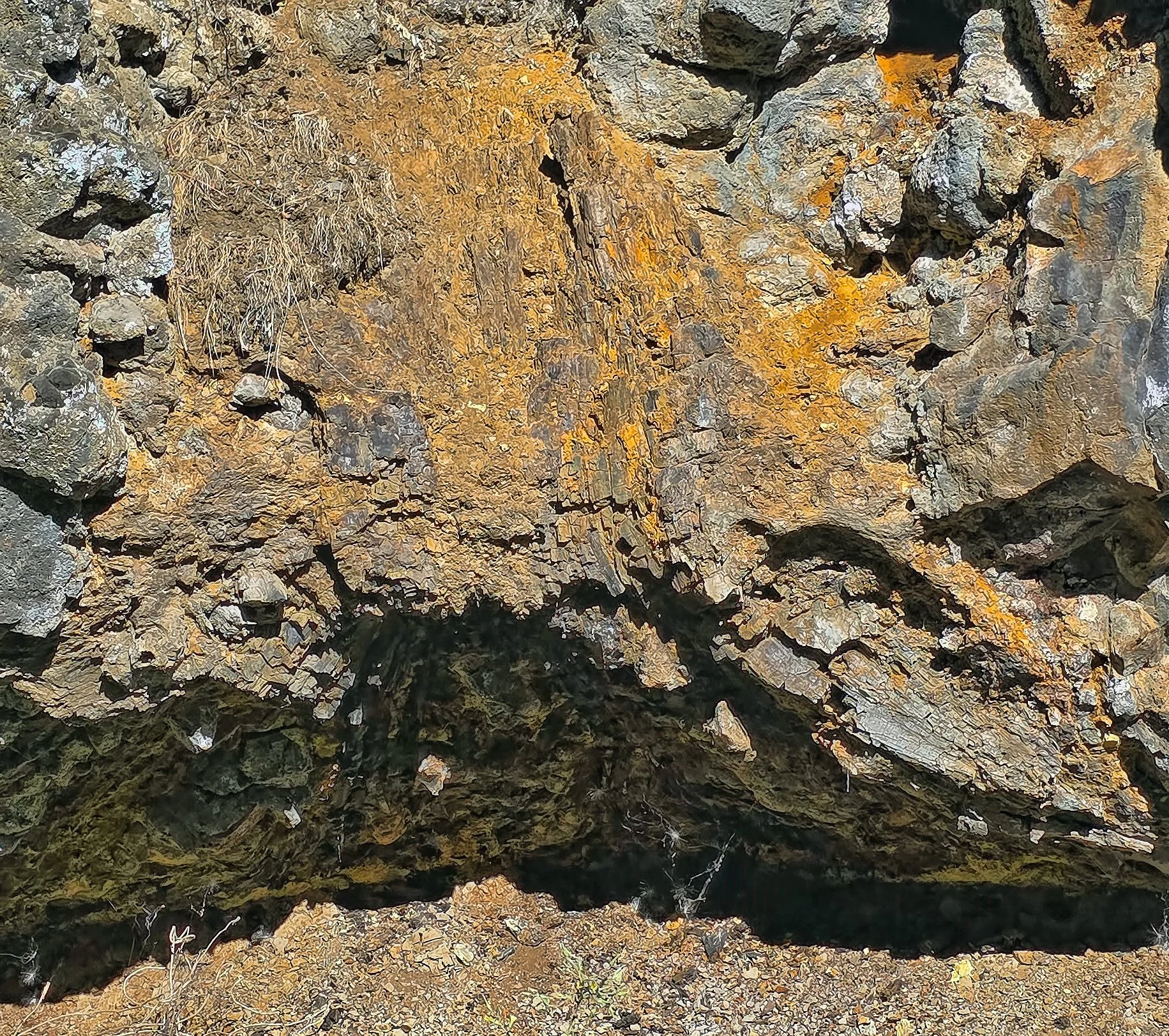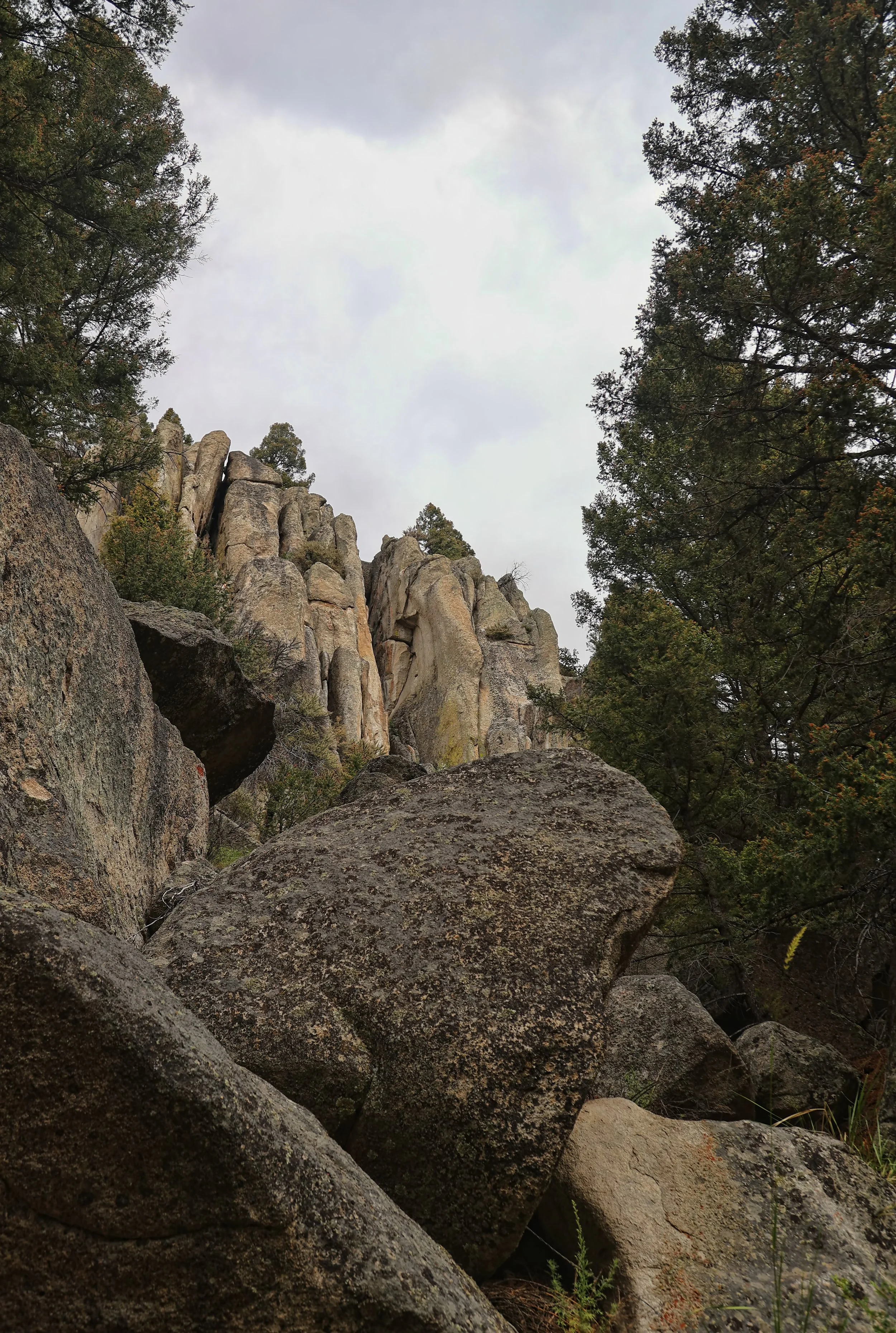displayed on a bedding plane on a fallen slab from the Chinle Formation (Upper Triassic (237-201.3Ma)) near Courthouse Wash. This sedimentary structure formed as muddy sediment dried and contracted due to reduction in water content, then buried and preserved with sandy sediments from a subsequent flood event.
A window into the Paradox Formation...
is found in Onion Creek where the peculiar geology of the salt-dominated formation is on full display. The light-colored gypsum caprock is highly structurally distorted, demonstrating the plastic nature of the buoyant salt body as it rises and displaces other clastic rocks in the geologic section.
View eastward, across the Onion Creek diapir. The Paradox Formation (Middle Pennsylvanian (315.2Ma - 307Ma)) is the light-colored unit in contact with the red beds of the Cutler Formation (Lower Permian (298.9Ma - 273.01Ma)).
Rockin' out at Navajo Rocks...
on the mountain bike trail system during a magnificent autumn afternoon in the high desert.
Red beds of the Dewey Bridge Member of the Carmel Formation (Middle Jurassic (174.1-163.5Ma)) share a sharp contact with the underlying cream-colored Navajo Sandstone (Lower Jurassic (201.3-174.1Ma)). (Click to enlargenate.)
The highest summit in Idaho...
is dusted with the first snow of the season on a stormy afternoon. A violent 6.9 magnitude earthquake occurred in the Lost River Range on 28 October 2983 and created a 21 mile (34 km) long fault scarp at the foot of the mountain front.
Borah Peak (12,662 ft (3,859 m)). Note the prominent fault scarps at the foot of the lowermost slopes created during the 1983 earthquake.
US Forest Service interpretive site along a fault segment created during the 1983 event. Borah Peak is at the center skyline.
My 8th grade earth science teacher...
stoked my early interest in geology and, next to my parents, Ellis Underkoffler is clearly the most pivotal person in my early formative life. Here we are, now years later, at a regional meeting of the National Association of Geoscience Teachers, Ellis having invited me to deliver the keynote address at the conference highlighting my adventurous cave research in Central America. It was a fun reunion. Inspiring teachers are important!
This living fossil...
first appears in the rock record about the time of the dinosaurs - Early Jurassic (201.3 - 174.7 Ma) - and it persists on the landscape today and is known by a variety of common names.
Horsetail (genus Equisetum).
The angle of repose of wheat...
is about 27 degrees to the horizontal as demonstrated by these piles of grain outside an elevator. This critical threshold describes the maximum stable slope that a dry, loose granular material can assume and is primarily a function of the grain size of the material involved. This concept is employed by geologists when assessing the stability of natural slopes.
Grain elevator near Ritzville, Washington. It’s been quite a good yield despite the dry conditions this year in the Columbia Basin.
Enigmatic natural mounds of soil and sediment...
dimple the eastern Washington landscape, so-called Mima mounds, where geologists have proposed multiple hypotheses in order to explain their puzzling origin. They seem to be relic features not being formed today, so I favor the periglacial origin, similar to the mechanism that creates patterned ground in Arctic regions.
Wide view of Mima mounds in Turnbull National Wildlife Refuge. Click on image to embiggen.
The low areas between the mounds often contain vernal pools of shallow water in late winter and early spring. Click on image to enlarginate.
Three tree molds ensconced in basalt...
bedrock occur along the Fish Lake trail, the result of an advancing lava flow into a standing forest during the Miocene Epoch. Imagine the snap, crackle, pop and hiss as the trees were overrun by the molten lava. Geology is everywhere, you just have to look!
Old railroad cut exposing a tree mold in the Wanapum Basalt, Priest Rapids Member (15.97-11.63Ma).
Base of another tree mold showing the flaring of the root collar in contact with the underlying paleosol. Note the silicified wood fragments that still exhibit cellular structure.
The strongly-jointed Humbug Spires...
near Butte, Montana offer a myriad of easy to moderate rock climbing routes on a smooth, spheroidally weathered granite.
Quartz monzonite of Cretaceous age (145-66 Ma) that comprises the Boulder batholith south of Butte, Montana. Orthoclase and plagioclase feldspars and quartz are the lighter minerals with accessory biotite and hornblende constituting the dark minerals.
This cobbly terrace edge remains stable...
after the dry winter and spring, with no evidence of any unraveling or failure whatsoever along the length of the escarpment. Castle Creek, slightly off the image to the right, is not likely to undercut this sedimentary terrace anytime soon. The singletrack remains safe to cruise.
A miniature lunar landscape...
created by the tiny and delicate craterlets made by raindrop impacts on a fine-grained surface, seen here on mud-cracked clayey-silts in the dry bed of Castle Creek.
Largest craters are only 2 to 3 millimeters in diameter.
The guts of the Moab Fault...
exposed for all to see near the entrance to Arches National Park, just above the Visitors Center. A chunk of the Moenkopi Formation is trapped in the brecciated zone in between a pair of extensional faults (yellow lines). More than a half-mile of vertical displacement has occurred across this zone, that is, the Entrada Sandstone lies considerably higher in the stratigraphic section than the Honaker Trail Formation, so the relative offset is UP on the left and DOWN on the right across the fault zone in the view seen below.
View is towards the northwest. Note the tour bus on the park road on the right side of image. Yellow lines are normal faults with downthrown blocks on the right side of each.
Like a liquid buzz saw...
the Gunnison River has deeply incised the Black Canyon, exposing the ~1.7 billion year-old Precambrian metamorphic rock that comprises the enormous Painted Wall, caught at sunrise and the moment of first light.
Wide pre-dawn view of the 2,250 foot (686 meter) high Painted Wall, showing pegmatite dikes intruding the foliated gneiss and schist creating a natural abstract mural nearly a half-mile high.
Bighorn sheep (Ovis canadensis) enjoying sunset near Cedar Point the evening before.
Happy Mount Saint Helens Day...
1980 USGS image.
An early aerial sunrise...
is captured over central Idaho as my trajectory boomerangs back to canyon country.
Mount Timpanogos looms more than 7,000 feet (2,130 meters) above greater downtown Provo, Utah and Utah Lake.
Dissected pediments extend below the Book Cliffs near Sunnyside, Utah.
An early morning departure...
from GJT to SLC and onward to GEG yielded several interesting views when the weather allowed. Remember, geologists always get window seats.
View northwestward across Grand Junction, Colorado shortly after departure. The sinuous dark area is the confluence of the Gunnison and Colorado Rivers.
View northward, turning into the Salt Lake Valley over Utah Lake with the snow-covered Wasatch Mountain front.
The historic earthen causeway for the Lucin Cutoff railroad line separates the Great Salt Lake into two waterbodies with differing aquatic ecologies.
A peculiar roller cloud, about 40 miles (64 km) in length along its north-south axis, sits atop and defines Hells Canyon in Idaho.
An interesting groundwater seep...
at the stratigraphic contact between the Cutler and Moenkopi Formations below Adobe Mesa bears some further examination, but it’s a difficult scramble to its location on steep and unstable slopes. Light-colored mineral deposits, likely either calcium carbonate (calcite) or calcium sulfate (gypsum), occur at the margins of the seep.
Peering into the abyss...
of Sevenmile Canyon north of Moab on a spectacular mid-winter day.
An immense pour-off defines the upstream end of Sevenmile Canyon, west of Arches National Park.
The Slick Rock Member of the Entrada Sandstone comprises the vertical walls of Sevenmile Canyon, capped by the Moab Member of the Curtis Formation (Middle Jurassic (174.1-163.5 Ma)). The Windows Section in Arches National Park on the horizon is eight miles (~13 km) distant.
Sediment aggradation will almost certainly occur...
in the ephemeral stream channel upstream of the newly installed concrete ford in Placer Creek, rather than being continuously transported across the structure when the stream is flowing. Engineers should have matched the elevation of the stream bed rather than maintain the road grade at the crossing. While this structure isn’t going anywhere in future floods, it will require maintenance after each event in clearing accumulated sediment, in perpetuity. It could have been self-maintaining, so let’s see how it performs over the next decade.
The brand-spanking-new $188,889 mega-concrete stream crossing structure on Placer Creek at the entrance of Round Mountain State Park.

